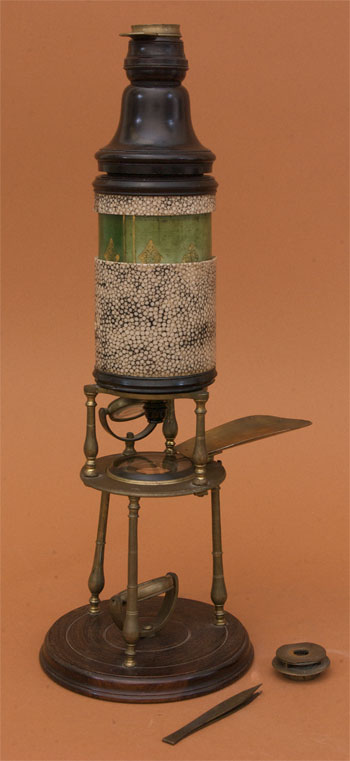 |
|||||
 |
 |
||||
 |
|||||
 |
 |
||||

Optics consist of three lens systems: the eyepiece, field lens, and objective. The single, bi-convex eyepiece lens is mounted at the top of the wooden cap piece and is protected by a brass "Slyding Head", also invented by Culpeper*. The field lens is mounted to the distal end of the Lignum vitae eyepiece. Culpeper microscopes were usually supplied with five objectives, however there are only four remaining with this instrument. They are mounted in Lignum vitae and marked with a notches. The objective is screwed onto the end of a tapered brass nosepiece ("snout"), which protrudes through a hole in the upper brass platform.
Sample illumination is via a Culpeper invention—the substage concave mirror—or from above (for opaque samples) via a bull's-eye lens. The circular stage has a recessed central opening (characteristic of later Culpeper third form) and a spring-loaded specimen holder. The sample platform has a mount for a fish-plate and/or forceps. The microscope sits on a circular Lignum vitae base 13cm in diameter. The complete microscope is approximately 36cm in height. The exact date of construction of this instrument is not known, but its features suggest this is a later model (No. 3) made between 1735 and 1738. Accessories include a brass forceps, bone sample slides, and brass fish plate.
This instrument has an oak pyramidal case with a single drawer at the bottom. Inside the case is the distinctive Culpeper trade card. In Culpeper's era, opticians would advertise their wares via a business, or trade card. Edmund Culpeper adopted the Cross Daggers motif of Walter Hayes**, to whom he was apprenticed in 1684. In 1706 Culpeper took over Hayes' shop located at "The Cross Daggers" in Moorfields London. In 1731 Culpeper moved his shop to the "Black & White House" in Middle Moorfields. The Culpeper trade card showed instruments made by his firm. These included surveying devices, quadrants, sundials, globes, and optical instruments such as the screw-barrel microscope and spectacles. The latest contemporary reference to Culpeper is 1738***. He went out of business or died c1740.
The construction materials—Lignum vitae, brass and vellum- or shagreen-covered cardboard—were chosen because they were inexpensive and uniform in shape and size. The method for making precision brass draw tubes had not yet been invented, so friction-focusing using brass would not have been possible at that time. Culpeper chose also to not include screw-thread focusing, as is found in Marshall-type microscopes, because it would have increased the cost of the instrument. Culpeper created an instrument that was low cost, functional, and beautiful, thus many of these microscopes were sold, and many remain to this day.
*Talbot, S. 2011. Bul. Sci. Inst. Soc. No. 108.
**Walter Hayes made high-quality scientific instruments from 1651–1692. He was particularly well known for his surveying quadrants and sundials.
***Clay, RS, and TH Court
Featured 05/2012, 09/2020